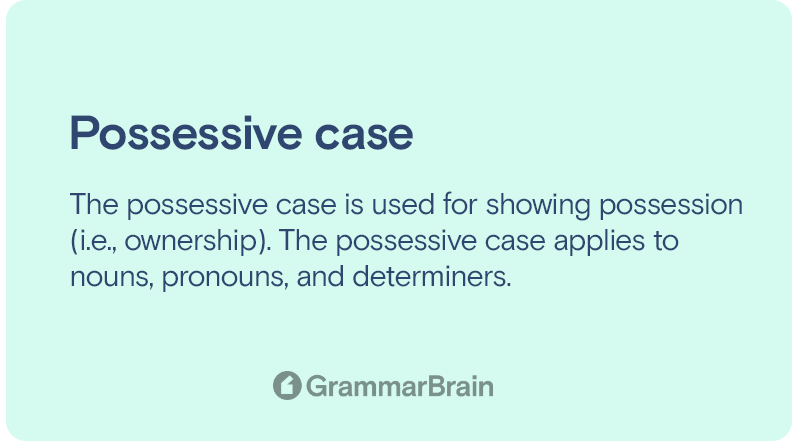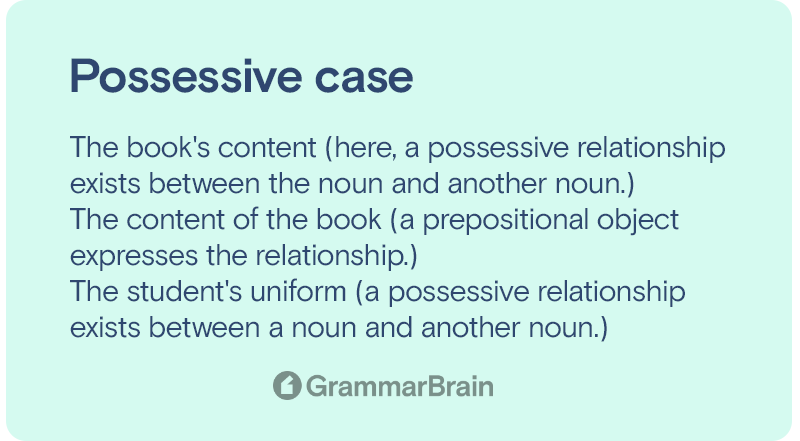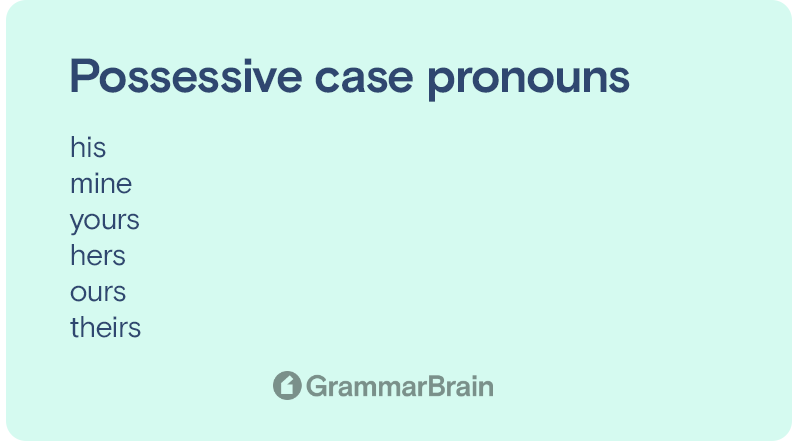What is the possessive case? For example, is it James or James’? Or is it Chris or Chris’? How do possessive case nouns work? How do possessive case pronouns work? These are all great questions when referring to the English language. Each question can get confusing, too. We’ll break down possessive case in this comprehensive guide.

What is a possessive case?
The idea of a possessive case in English talks about a noun, pronoun, or adjective’s relationship with other elements present in a sentence.
Usually, the possessive case refers to ownership or possession, such as Rick’s car or the teacher’s opinion. It is the only case where the noun can change its form (e.g.,, Rick to Rick’s).
This simple change can change a thing, a person, or a place in the possessor or owner.
It is important to note that straight possession or ownership is not always defined by a possessive case. Sometimes it gives information about authorship or origin, measurement, source, and description.
| Apostrophe for Possessives | Apostrophe for Contractions |
| Amy’s swim class | they + have = they’ve |
| Karen’s car | are + not = aren’t |
| Robert’s vehicle | they + will = they’ll |
Definition of possessive case
A possessive case helps define possession. It applies to nouns, pronouns, and determiners. The expression helps understand that something belongs to someone or shows a relationship between one or more people.
The ownership is depicted using the apostrophe and “s” to the noun if it is an animal or person. Sometimes the word “of” is used to define a relation between two or more things.
| Form | Definition |
| Possessive Case | A possessive or ktetic form is a word or grammatical construction used to indicate a relationship of possession in a broad sense. This can include strict ownership, or a number of other types of relation to a greater or lesser degree analogous to it. (Wikipedia) |

Possessive case nouns
The possessive case in nouns is updated by adding “s” or an apostrophe to the noun. It is also established that employing an “of” – beginning adjectival prepositional phrase to denote a relationship is often known as the genitive case.
Example:
- The book’s content (here, a possessive relationship exists between the noun and another noun.)
- The content of the book (a prepositional object expresses the relationship.)
- The student’s uniform (a possessive relationship exists between a noun and another noun.)
- The uniform of the student (a prepositional object expresses the relationship.)
- Possessive nouns will have ‘s’ when they are singular (book’s) and when plural (books’)
Similarly, the possessive noun can be singular or plural:
- Book’s content
- Book’s contents
- Books’ content
- Books’ contents
It is important to note that if a possessive word in the plural does not conclude with s, it will contain a ‘s: student’s, book’s
If a possessive noun in the singular or plural ends in “s,” the style guide will differ on whether to use an apostrophe or “s.”
In the English language, either of the possessive markers is correct. Many people tend to choose possessive noun pronunciation.
Compounded with shared possession
When a possessive noun is compounded with shared possession, the possessive is added to the second-to-last noun. Joseph and Mary’s house(the house is owned jointly).
Both nouns will have a possessive marker if the compound has a separate possessor.
Similarly, the possessive form is used for the final word of the compound when the possessive noun is a hyphenated compound.
Sometimes, there is no need to indicate possession if the possessive noun is an animated object, such as a building.

Possessive case pronouns
When it comes to possessive case pronouns, the pronoun usually replaces then no one when indicating possession or ownership. In English, there are 6 possessive case pronouns.
- his
- mine
- yours
- hers
- ours
- theirs
Examples:
- The idea is exclusively John’s
- The recommendation is exclusively his (here, John’s is replaced by the possessive word his.)
- My name is Anne, and that bicycle belongs to me
- The bicycle is mine. (Anne is replaced with the possessive pronoun mind.)
- The umbrellas are the Franks
- The umbrellas are theirs. (Frank is replaced with theirs as the possessive pronoun.)
One important factor is that possessive case pronunciation never contains an apostrophe.
It is important to note that the pronoun is never used to replace a non-living item as a possessive pronoun.
Possessive case determiners
The possessive case determiners are used to denote who is the owner or possessor of a thing.
Example: your, my, his, her, our, their.
Just as all determiners possessive determiners come at the beginning of a noun phrase, they are present before any adjectives.

Examples of the possessive case
- This is my bag.
- His name is Jonathan.
- Her first name is Maria.
- The cat licked its paw happily.
- We have sold our land.
- The students thanked their teacher.
- I like your way of working.
- Both your children are very responsible.
- Examples of the possessive case
- This is Astry’s car.
- This is his machine.
- Jordan’s name is written on the bench.
- His name is written on the rock.
- Is this your friend?
- What is your address?
- This is Robert’s house.
- This is his school.
- This assignment is Anne’s.
- This is his project.
- Is she your sister?
- This is Robin’s writing.
- This is his writing.
- This is Adam’s book.
- This is her dog.
- This jewelry is mine.
- We are at his place now.
- Bobby lives at his uncle’s place.
- We are coming to your place tonight.
- Everyone enjoys Florida’s climate.
- Diabetes symptoms should be treated immediately.
- House’s roof should be checked at regular intervals.
- The laundry’s smell can be very annoying.
- Today’s newspaper contains the news.
- We have a month’s work left.
- How much is the lawyer’s fee?
- Frog’s croaking can be heard from a distance.
- We like the juice’s flavor sold here.
- My father-in-law’s advice.
- Yellowstone National Park’s hours.
- We want a new t-shirt’s logo.
- Cat’s toy is lying on the sofa.
- The winner’s edge is all in attitude, not attitude.
- Nicole’s brother is a doctor
- Mary’s dog has gone missing for a week now
- My brother’s friend will come home this weekend
- Mark and Pete’s room is relatively small for all of them.
- My mother’s recipe for chicken curry has always brought my favorite.
- The chef’s new creation was an instant hit
- The judge’s verdict was not well accepted
- Nobody was able to find the child’s toy
- The earth’s climate has changed significantly after global warming.
- His house looks like a royal palace
- My brother in laws cousin got a job in the USA.
- Are you going to Adam’s bachelorette party?
- I borrowed my uncle’s car for the event.
- The Malayalam movie’s rating is very high.
- Can you fetch me your bottle?
- The student’s project works were submitted according to the roll numbers.
- The boys’ team is very competitive.
- All the clocks need to be changed.
- The child’s parents kept looking for him for 3 days and still could not find him.
- Nobody is in a fever of the bank’s policies in recent times.
Using possessive nouns for compound nouns
In English, a compound noun is often seen as a noun with more than one noun and a plural meaning. There are different ways of using them depending on the compound noun.
There is a possibility of combined and separate ownership in these types of sentences.
| Form | Example |
| Singular noun | Sarah’s |
| Plural noun | Women’s |
| 2 or more people | Kim and Adam’s |
| Singular noun ending in “s” | James’s and James’ |
| Plural noun ending in “s” | Parent’s |
| 2+ people | Kim’s and Adam’s |
Using an apostrophe to form possessive nouns
Consider the following examples. There are different sides of the s, but both uses are correct.
- The cow’s shed
- The cows’ shed
The apostrophe will be before the s for a singular possessor. It will be after the s when there multiple processors.
Here “cow” and “cows” are the processors. The placement of the apostrophe has nothing to do with the shed. The thing under possession can be either singular or plural. It will not affect the apostrophe.
How to identify possessive case
With the noun, the possessive case is typically denoted when preceding with of or by adding ‘s at the end. The possessive case is mainly used for showing possession. It is applicable for nouns, pronouns, and determiners.
Possessive case vs. the other 7 case types
The possessive case help determine relationships between a person, place, or thing. However, experts refer to it as a genitive case.
It is denoted in either of two ways—singular noun followed by an apostrophe and the letter -s.
Apostrophe alone follows a plural noun ending with -s or -es.
Following are the different categories of genitive cases in use:
1. When denoting occupation, ownership, or possession. For example, “John’s car is under repair.” The noun to which the apostrophe or the Apple stores and s are attached is the dependent or modifier.
2. When denoting relationships, as in the case the department’s head is retiring this month. The same sentence can also be written without using the apostrophe. The department head is retiring this month. The meaning will be slightly different. In the second sentence, the reference is to a person identified as the department head. However, in the genitive form, the department and the person are treated as separate entities.
3. The genitive form can also determine agency or representation. The board’s members consulted before the meeting. The member of the board consulted before the meeting. Here the emphasis is slightly different and more accurate.
4. The description is another purpose of the genitive. She admired the jeweler’s sheen. Here the sentence talks about the fabric, but the phrase is a description.
5. Relating to a person or place that serves as the subject. The officer’s report was complete. In this case, there can be slide distinction in meaning even with similar construction.
6. For describing the role of a person, place, or thing identified as the object of a sentence. The baby’s birth was uneventful.
7. The most complex of the lord is the one where a phrase including of is truncated. For example, “The employee was given two weeks” notice. In place of “The employee got notice of two weeks. Most people make the mistake of treating “two weeks” as the modifier for notice. The correct approach is to place the apostrophe correctly to indicate the genitive case.
Possessive case grammar rules
A possessive case indicates ownership or possession. With the correct placement of ‘s or sometimes only the apostrophe in the form of a noun can change from a simple place, person, or thing to a thing that owns or possesses something.
FAQs
What are the 7 possessive nouns?
The 7 possessive nouns are mine, ours, yours, his, hers, theirs, and its.
How many possessive cases are there?
The possessive case indicates ownership or possession. It is typically divided into seven categories based on the genitive case.
How many cases are there in grammar?
In English grammar, there are five cases: genitive, nominative, accusative, vocative, and dative.
How do we form the possessive case?
Singular nouns form possessive cases with the inclusion of apostrophes and s. Plural nouns form possessive cases with only the inclusion of an apostrophe.
How do you know if a case is possessive?
Along the noun, the possessive case usually gets a proceeding “off” or by adding s or just an apostrophe at the end.
Inside this article
Fact checked:
Content is rigorously reviewed by a team of qualified and experienced fact checkers. Fact checkers review articles for factual accuracy, relevance, and timeliness. Learn more.
Core lessons
Glossary
- Abstract Noun
- Accusative Case
- Anecdote
- Antonym
- Active Sentence
- Adverb
- Adjective
- Allegory
- Alliteration
- Adjective Clause
- Adjective Phrase
- Ampersand
- Anastrophe
- Adverbial Clause
- Appositive Phrase
- Clause
- Compound Adjective
- Complex Sentence
- Compound Words
- Compound Predicate
- Common Noun
- Comparative Adjective
- Comparative and Superlative
- Compound Noun
- Compound Subject
- Compound Sentence
- Copular Verb
- Collective Noun
- Colloquialism
- Conciseness
- Consonance
- Conditional
- Concrete Noun
- Conjunction
- Conjugation
- Conditional Sentence
- Comma Splice
- Correlative Conjunction
- Coordinating Conjunction
- Coordinate Adjective
- Cumulative Adjective
- Dative Case
- Determiner
- Declarative Sentence
- Declarative Statement
- Direct Object Pronoun
- Direct Object
- Diction
- Diphthong
- Dangling Modifier
- Demonstrative Pronoun
- Demonstrative Adjective
- Direct Characterization
- Definite Article
- Doublespeak
- False Dilemma Fallacy
- Future Perfect Progressive
- Future Simple
- Future Perfect Continuous
- Future Perfect
- First Conditional
- Irregular Adjective
- Irregular Verb
- Imperative Sentence
- Indefinite Article
- Intransitive Verb
- Introductory Phrase
- Indefinite Pronoun
- Indirect Characterization
- Interrogative Sentence
- Intensive Pronoun
- Inanimate Object
- Indefinite Tense
- Infinitive Phrase
- Interjection
- Intensifier
- Infinitive
- Indicative Mood
- Participle
- Parallelism
- Prepositional Phrase
- Past Simple Tense
- Past Continuous Tense
- Past Perfect Tense
- Past Progressive Tense
- Present Simple Tense
- Present Perfect Tense
- Personal Pronoun
- Personification
- Persuasive Writing
- Parallel Structure
- Phrasal Verb
- Predicate Adjective
- Predicate Nominative
- Phonetic Language
- Plural Noun
- Punctuation
- Punctuation Marks
- Preposition
- Preposition of Place
- Parts of Speech
- Possessive Adjective
- Possessive Determiner
- Possessive Case
- Possessive Noun
- Proper Adjective
- Proper Noun
- Present Participle
- Prefix
- Predicate



